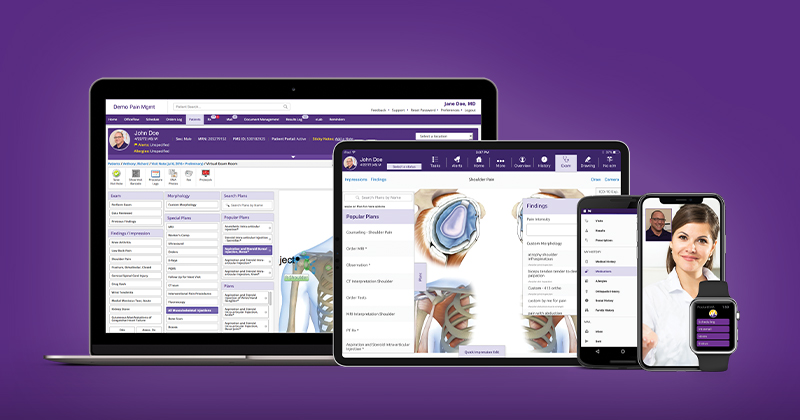Top Considerations for Pain Management EMR Software

It isn’t just about features, it’s about what you’re getting back.
Software that powers pain management practices should be just as innovative as the medical professionals who are advancing this relatively new field of medicine. How do software companies get there? True understanding. Understanding of the medical specialty itself and the individual needs of pain management physicians, administrators, medical staff, and, of course, patients. After all, software isn’t just about fancy features, artificial intelligence and apps. It’s about the value it provides to the people who interact with it every day. So, if you’re in the market for new pain management EMR software to power your practice, here are a few things you’ll want to consider:
Does Your Pain Management Software Understand Your Specialty?
How do you know if the software you’re considering actually understands your specialty? It brings together features, content and technology to significantly reduce unnecessary clicks and data entry. It feels like the kind of software you would design for yourself because it was programmed by someone like you—a fellow pain management specialist.
Features to look for:
- Pain management-specific content, workflows and analytics
- Milligram morphine equivalent (MME) calculators
- Direct access to a PDMP database
- Workers comp capabilities
Does Your Software Understand You?
Now that you’ve established that your software understands your specialty, you’ll want to make sure it understands you. Your quirks, your preferences, your workflows, your protocols, your diagnoses, even the way you document. After all, what good is your software if you put data and preferences in and get nothing in return? Thanks to technologies like adaptive learning and automation, our software options have started to become more sophisticated. Not only do they come to us with built-in content and capabilities, they learn from us as we go about our business of documenting procedures, writing prescriptions, ordering tests, etc. Soon, our EMR begins to remember our top treatments for specific diagnoses. And in some cases, we can even save our most common protocols to use again and again.
Does Your Software Help You Track Treatment Outcomes?
With the power of visible, actionable data at your fingertips, you can track treatment outcomes, identify trends, track opioid use and identify high-risk patients. Once you know where action needs to be taken, you can reach out to patients and adjust protocols, leading to better patient experiences—and even helping you to better manage your patients’ medication regimens.
Does Your Software Support Your Staff?
For many of our demos, doctors and administrators will invite other staff members so they can experience how modmedⓇ Pain Management will make a difference, not only for the clinical team, but for the billing team and the front office. That’s why we’ve created features that make their jobs easier as well. Our scheduling tools make it easy to see and fill open appointment slots. You can access information from the clearinghouse and our payment platform, right from our Practice Management software. And our internal messaging platform makes it easier for staff to communicate.
Was Your Software Built for a Dynamic Field?
We’ve all heard the expression that “the only constant is change”, and that is especially true in the field of pain management with its constantly changing regulations and advances. And let’s not forget: your practice is growing and changing, too.
So, if you’re looking for flexibility, you’ll find more of it in a cloud-based software platform. The cloud has a number of advantages over on-premise environments:
- Automatic software updates
- Innate mobile capabilities
- Ease of scalability
However, it should also be understood that your cloud-based software is only going to be as good as the vendor that is providing the updates. And those regular updates should not be limited to technical enhancements and security updates. They should also include updates to your software’s pain management medical content and medical coding. Working with the latest information will only help your practice be more efficient, reducing the need for manual lookup and workarounds.
Can You Depend on Your EMR Vendor for Support?
The answer to that question should of course be a resounding “Yes!”. But, is there a way to know if you will receive the kind of service you deserve BEFORE you even become a customer? Yes. And here’s how:
- Read reviews from actual clients and check out their case studies.
- See if the company has been recognized by reputable third parties for service.
- Ask about the support they provide during the implementation process.
- Find out how the company trains customers on new software updates and features.
- Find out if the company is receptive to client feedback.
- Ask about advisory/concierge support services.
Does Your Software Help Create Positive Patient Experiences?
Outside of your practice, patients depend on their mobile devices and computers to remind them of important appointments, book reservations, pay bills, sign documents, message friends and track their health data. Their reliance on mobile devices, and the instant feedback they provide, has changed their expectations in terms of how they interact with all kinds of companies and providers, including your practice. So, if you’re shopping for new software, you’ll want to consider options that bring the technologies your patients are already accustomed to using into a healthcare setting. Options that send patients appointment reminders, provide easy access to their health information, allow them to pay bills online or through their mobile device, make appointments, sign intake forms virtually and more.
Does Your Software Interface with Other Technologies You Already Depend On?
Can your software easily connect with third-party technologies and exchange information with health information exchanges, registries and hospitals? If interoperability is important to your practice, be sure to ask your EMR vendor about available interfaces and connection opportunities.
Does Your Software Have It All?

What do we mean by all? We mean everything it takes to run your practice—an EMR, Business Operations Services, Practice Management, analytics, payment processing, telehealth, patient engagement tools and more. And the best part? All it takes is one login to access all of it. After all, modmed Pain Management is a single platform that pulls patient data from one place—closing the loop between your front and back offices and making your practice run more efficiently.




